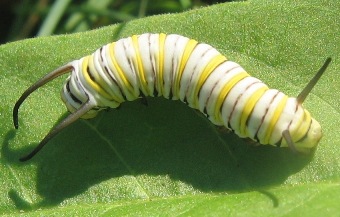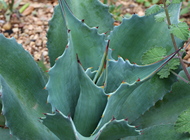 |
Asclepias curassavica |
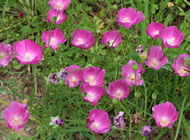 |
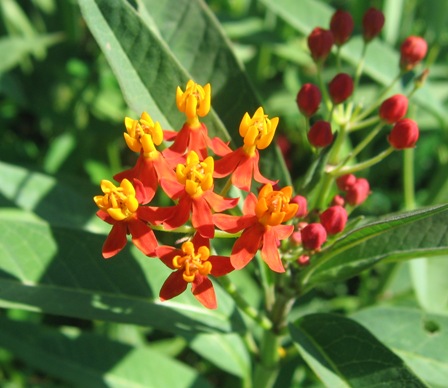
| | The species has red-and-yellow bicolor flowers |
|
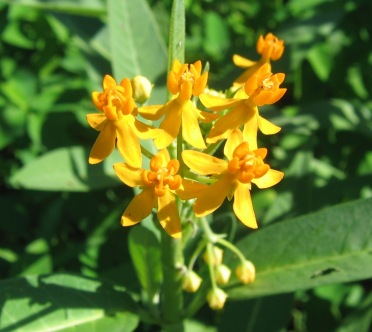
| | 'Silky Gold' |
| Common name |
tropical milkweed; bloodflower |
| Family |
apocynaceae |
| Life cycle |
tender perennial |
| Flowers |
red, yellow |
| Size |
2-3' |
| Light |
sun |
From seed  |
germinate warm; self-seeds in our garden
detailed seed-starting info below
|
| Seed ripens | late August |
A tender member of the milkweed family. We'd grown these years ago, but had fallen back upon their hardier cousins until this year. Spurred in part by their colorful flowers, and in part by their superior attractiveness to monarch butterflies, I decided to give them another try. I think they'll turn into a staple of our annual garden - not only are the flowers even nicer than I remembered, they successfully attracted a monarch mommy - we found their caterpillars by early August. The one pictured here is a little one, not nearly ready to pupate.
Years later, after moving to Houston, we decided to give tropical milkweed another try – this time hopefully as a true perennial. We purchased a mature plant and were impressed with its constant flowering, into late fall, but it was killed down to the ground by a January freeze. Fortunately, its roots survived, so that by mid-March we had a perky plant ready for another season – and by mid-April, it was blooming.
|
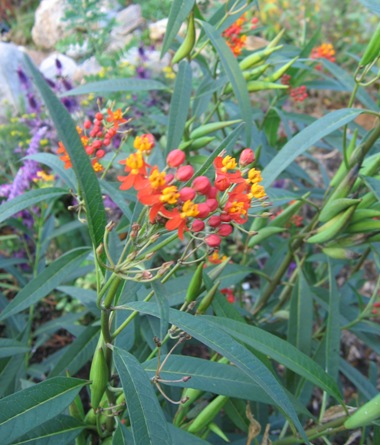
| | Late October - most of the flowers have gone to banana-shaped seed pods, but a few keep on providing their cheerful color well into fall |
| 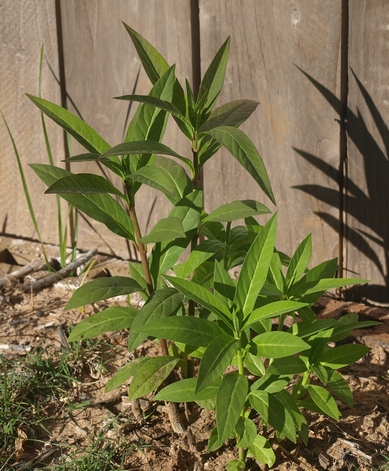
| | Strident regrowth in mid-March after being knocked down by a freeze in January |
|
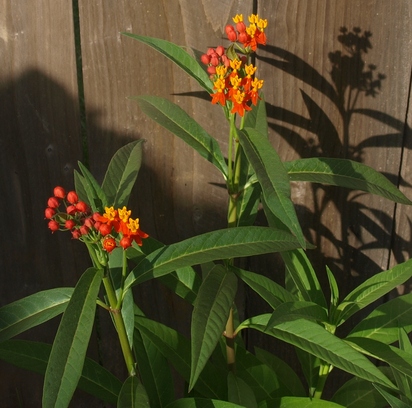
| | Early to bloom in our Houston-area climate: this photo mid-April |
| 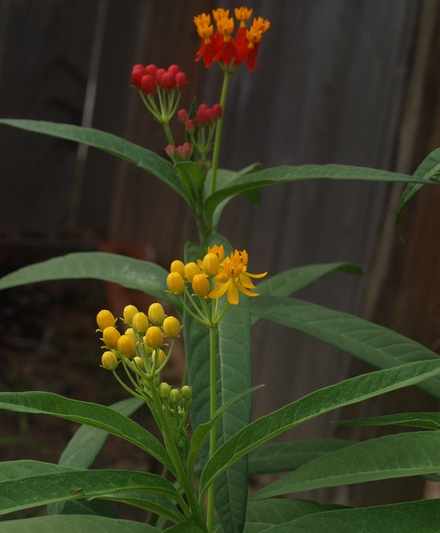
| | Curious: the two flower colors, shown in photos above on different plants, occur on the same plant here |
|

| | Seedpods messily releasing their seed fluffs. A few of them always manage to land in conducive spots, so the milkweed population is self-sustaining in our garden |
|
In our garden, this plant grows in the following areas: back fence border, back foundation border, north foundation border Seed for this plant is included on my seed trade list About my plant portraits
PlantLinks to other web pages about Asclepias curassavica
Visitors to this page have left the following comments| Susan | Feb 01, 2009 | Hello :)
Wow! Love your site so far! I'll be planting 4 of these in our gardens this year. I am amazed by your not having a single aphid (not that I can see) on your plant. I had to hose them off everyday...and in the process I hosed off Monarch Cats and drowned the nearby plants...Good Grief! This year I'm going to plant some 'Moonshine' Yarrow nearby to hoefully attract some lady bugs...and Alliums to help deter some of the aphids.
With my luck, I'll wind up confusing all the bugs and the lady Monarchs won't even lay their eggs...LOL
I get aphids too on my milkweeds - but I'm not a tidy gardener, so I tend to let them be. Our garden should have a healthy population of good bugs, but not enough to knock bigger infestations of aphids out. |
| J. Imhoff | May 01, 2009 | Hi, Rob, Love your site and I'm always referring to it for details on your plants and butterflies. Thanks for all the info!
Now I'm wondering how long it took your A. curassavica to get to 'garden size' for the monarchs. I just started seed yesterday, and I'm wondering if it will be usable for the butterflies by the time they arrive in July/August.
Thanks. Judy
I start mine around mid-March, so you're about 6 weeks behind. But I think your plants will catch up quick enough - they wait till weather gets warm to really push. I also think I had some volunteer seedlings last year get to flowering size by mid-summer, and those sure didn't get started until mid-May. |
| Susan J, | Jan 10, 2010 | Am wondering about the long-term viability of seed of A. curssavica. I have seed left over from 2 years ago, but was going to throw it out as I thought it had lost its viability by now. I found it in a brown paper bag at room temp, so not stored properly. I actually thought I had thrown it out a long time ago, but you know how it is with bags and bags of collected seed at our disposal. Some gets overlooked.
Am wintersowing A. hirtella, A. purpurescens, A. viridis, and A. tuberosa this winter. Already growing A. incarnata grown from seed.
A. curassavica is higher in the cardiac glycosides that protect the Monarch caterpillar somewhat from predators, which is why the Monarch favors it over other milkweeds.
Hmm, I nearly always manage to collect some seed from my tropical milkweeds, so I've not had occasion to test its long-term viability. However, as you'll see in my seed comments for A. tuberosa, that species maintains seed viability for a good number of years. So it's worth a try. |
| Jennifer Beacham | Mar 22, 2010 | i have a question. I am trying to germinate A. Curs. but i am a total "newbie" at germinating anything. I'm on day 8 now and have about 3 seeds to germinate (only about 1-2mm out of the seed) out of about 1000 seeds! I'm trying very hard to not cry over this--but i'm really tired of hearing how easy these are to germinate since i've been such a failure. some tomato seeds i planted at the same time are already 1" high. I've tried to keep the temp. just right and kept them moist. I put them in the warm water first just like the package said (made sure the water was hot, placed them all in the glass and let it sit there for 24 hours). What have I done wrong? Did I over water? Some seeds are a tiny bit below the surface and some have ended up pretty much resting on the surface. some look dead but others look like their bellies are "swollen", but they're not "popping." I'm so discouraged i just want to scream. thank you for any input.
How warm is the area where you're germinating the seeds? I keep mine decidedly warm (well above room temperature) for germination, which occurs in about 5-8 days. |
- Seed from '05 trade. 'Silky Gold' baggy 70F (27d) - 75F (100%G, 2d); 'Red' baggy 70F (21d; 40%G, 4-17d) - 75F (25%G, 3-5d)
- Seed from '06 garden. Baggy 75F (91%G, 6-11d)
- Seed from '07 garden. Baggy 75F (95%G, 5d)
- Seed from '08 garden. Baggy 75F (100%G, 4-6d)
- Seed from '09 garden. Baggy 75F (100%G, 5-8d)
- Seed from '09 garden. Baggy 75F (97%G, 3-6d)
- Seed from '11 garden. Baggy 75F (94%G, 7-9d)
- Same seed as above. Baggy 75F (83%G, 10-15d)
- Same seed as above. Baggy 75F (63%G, 6-16d)
- Seed from '17 garden. Baggy 70F (50%G, 6-16d)
I welcome comments about my web pages; feel free to use the form below to
leave feedback about this particular page. For the benefit of other visitors
to these pages, I will list any relevant comments you leave, and if
appropriate, I will update my page to correct mis-information. Faced with an
ever-increasing onslaught of spam, I'm forced to discard any comments including
html markups. Please submit your comment as plain text. If you have a
comment about the website as a whole, please leave it in my
guestbook. If you
have a question that needs a personal response, please
e-mail me.
Last modified:
December 08, 2024
Contact me
|





